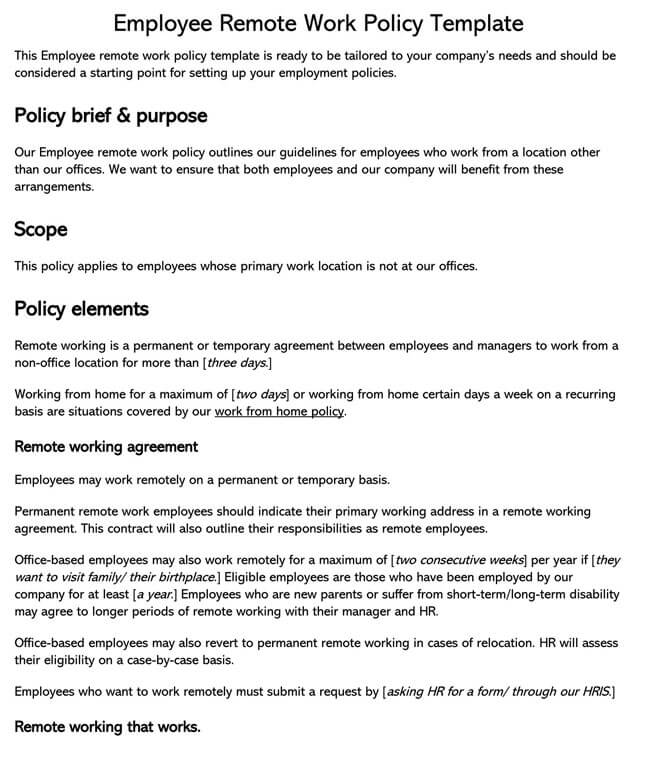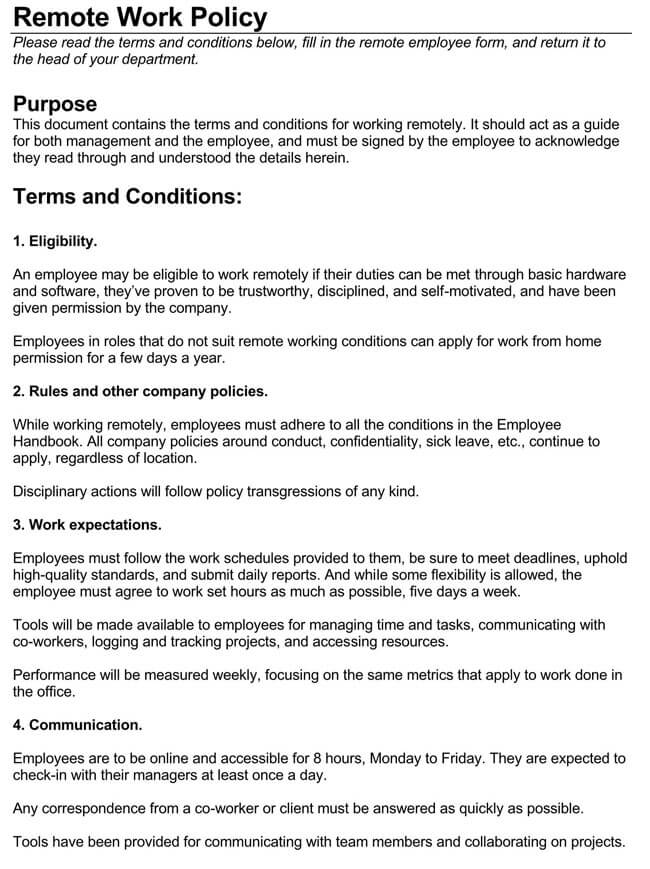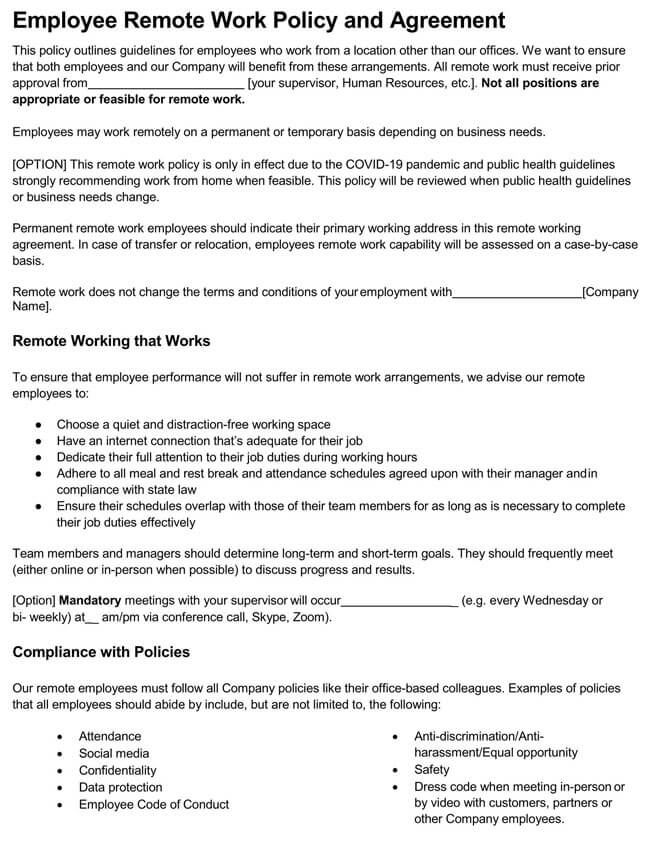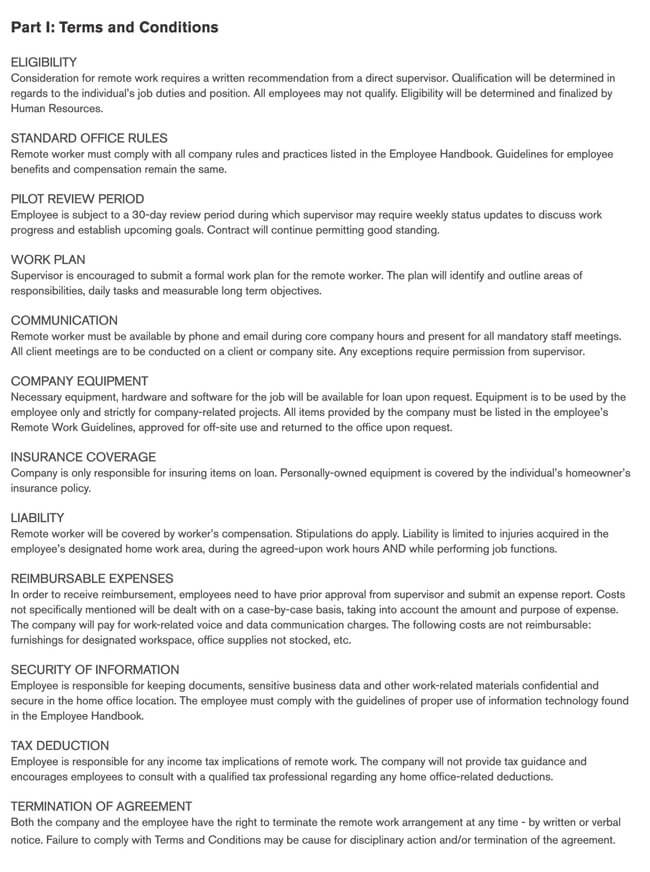In today’s world, most businesses are drastically allowing their employees to work remotely. While it is an upward trend, there are lots of benefits and opportunities businesses reap out of it.
EXAMPLE
It creates a better work balance and flexibility. With the attempts to minimize the spread of Covid19 through physical interactions, most people are encouraged to work remotely from home.
But before that, an organization needs to set guidelines that will regulate employees to work from a non-office location through an Employee Remote Work Policy.
Remote Work Arrangement
When there is a need to work from home, the employee will put forward the request to the management. Upon receiving such requests, the management will sit down and discuss them. If they agree, the request will be approved, and the necessary remote work arrangement arrived.
Usually, the company will consider remote work arrangements as an extension of its physical office. Therefore, the employee is expected to comply with the rules and regulations that the company shares within its physical offices.
Employee Remote Work Policy
The policy is a document that contains guidelines that regulate employees who work from non-office locations. Since the onset of the novel coronavirus, millions of people across the world have made remote work arrangements with their bosses to work from home. But the buck doesn’t stop with the covid19. There are various circumstances where an employer may decide to make remote work arrangements with their employees.
EXAMPLE
An employer may be attending to a sick relative at home but still continue with their jobs online. Or, an employee may decide to work from home to avoid distractions from the office environment.
Regardless of the reason, it’s important to note that working remotely does not affect productivity or output whatsoever.
Other names
Employee Remote Work Policy is sometimes referred to as effective work from home policy, remote work policy, work from home policy, or work at home policy. Depending on your choice, the above-mentioned names will mean a similar thing altogether.
Free Templates




Laws and Regulations
In every workplace setup, there should be a properly defined regulatory framework. This is meant to guide the employees as they go about their business. Similarly, when working remotely, employees should still adhere to the workplace regulations. It is therefore imperative for an employer to understand the laws and regulations that will best apply to their remote employees.
Here are some useful information to know:
Purpose of a remote work policy
The main purpose of the policy is to issue guidelines to employees working remotely. For any organization to run smoothly, there should be a regulatory framework to be followed to ensure order. Similarly, the policy guides both the management and the employee as they go on with their business on a remote setup. That’s said, every employee should sign the policy before embarking on remote operations.
Collaborative documents
Depending on the company rules, the employer may choose to present the policy alongside Employment Contracts or Employee Handbook. The policy document is often created as a collaborative effort between human resource departments, C-level executives, business leadership, and information technology departments.
Applicable law
While there is no distinct law that directly addresses the policy, federal protections may apply to remote workers. These include the Fair Labor Standards Act (FLSA), Family and Medical Leave Act (FMLA), Workers Compensation, and Discrimination in Employment Acts.
Key to Effective Remote Work
Transitioning from the traditional physical office setup to a remote setup is often challenging for many companies. However, there are certain measures that if put in place can necessitate a smooth transition.
The following are some useful information every employer should know to ensure an effective remote work:
Practical communication tools
There are various practical communication tools available in the present world such as skype, google drive, and slack -thanks to the improved technological advancements. The modern telecommuting options are advantageous in necessitating remote work programs. They help clarify the level of engagement hence improving the retention and productivity of an organization.
Right jobs for telecommuting
According to the latest reports, the number of employees shifting to remote work arrangements has significantly grown in the United States. Since the traditional work setting is rigid and time-consuming, certain job types still require an employee to attend the offices in person. These include the manufacturing industries, brick, and mortar manufacturing, among others. Nonetheless, other job types such as accountants, teaching, and food delivery services have shifted to the remote working setups due to its flexibility, time-saving among other benefits.
Right employees
For an employee to qualify as a good remote worker, he or she must possess the following qualities:
- They should be able to work with little or no supervision.
- They should possess strong communication skills.
- Have strong organizational skills
- Obedience to set deadlines
- Avail themselves during working hours
- Have good problem-solving skills
- Should be highly productive
- Avail themselves for any office meetings
Writing a Professional Remote Work Policy
Creating an effective policy isn’t a walk in the park. Fortunately, we have made the process simple for you by bringing all the information you will need together.
If you are wondering where to start, the following guides will help you create the policy like a pro:
Determine the roles
While working remotely has been proven to be more productive and flexible, not every job can be done remotely. Some of the jobs that can be done remotely include customer service jobs, programming, data entry, accounting, tutoring, translation jobs, among others. On the other hand, there are jobs that aren’t suited for remote working. These may include designs, videography, and c-suits, etcetera. Therefore, it is advisable that you first write roles that will be carried out remotely and those that require traditional office attendance.
Rules and company policies
Once you have noted down the roles to be done remotely, you now need to set the rules clear. While the employees won’t attend the physical office environments, standard rules and regulations will still apply.
Some of the common rules that will apply for remote workers include:
- Attendance policy
- Codes of conduct
- Sick leave
- Cell phone policy
- Sexual discrimination and harassment
- Employee confidentiality agreement
- Employee handbook
Constructing the work plans
The management, together with company supervisors, will then formulate a working plan for the remote workers. Each employee will be assigned duties that are in line with the company goals and objectives.
When rolling out the working plan, the management should also provide the necessary resources to facilitate remote working. These include software, technology, and electronic devices (laptops, internet connections) and technical support.
Furthermore, the management will also pay close attention to how the employees’ performance will be assessed. Depending on the employees’ role, appropriate measures should be put to determine their productivity and contribution towards meeting the company goals and objectives.
Decide on communication practices
While this comes with no surprise, communication is the backbone of remote working. More often, the employees will want to communicate with the managers and fellow colleagues. Therefore, as an employer, you need to set up a proper communication channel. Let your employees know what time they are supposed to check in for virtual meetings, project deadlines, how they will report their progress, among others. Fortunately, there is a wide range of communication software that can be used to necessitate virtual meetings, remote presentations, and other forms of communication.
Issues of insurance and liability
While your employees will be working from a remote environment, they are still part of your company. This means that their safety and security should remain your utmost concern. Therefore, you need to guarantee them that they will be compensated in case they get injured, sick, or experience any other loss while in the line of duty.
Add security measures
Since your employees will be using the internet to share work-related information from their remote setting, it’s important to invest in security options. Remember that there is certain company information that is always confidential. In order to prevent data leaks or any other exposure of confidential information, your remote policy needs to provide your team with security features such as virtual private networks (VPN). Also, the remote computers need to be updated with antivirus software to prevent cyberattacks.
Review compensation
As your employee’s transition from traditional work set up to a remote setting, you need to let them know any salary changes that accompany the same. In the same line, you can also let the employees know the reimbursable expenses and the procedure to make such claims.
Discuss office equipment and dedicated workspace
In your policy, you will discuss the required office equipment your employees may want. Also, as an employer, you may want to know if the employee is comfortable with their remote workspace.
Analyze covered expenses
Here, you will explain to your employees whether there are any covered expenses associated with remote working. These expenses may include medical treatments, accident covers, or any other occurrences that will be covered by the employer.
Finally, goals and expectations
The employer should explain in the policy document his/her expectations and goals of every remote worker. These goals should be easily measurable and should conform to the company’s overall objective.
Implementing the Remote Work Policy
While creating an effective work policy is one task, implementing it is another. Since the policy is part of the organization’s legal documents, the employer should always follow the legal process of implementation.
Here is some useful steps the employer need to adhere to:
Decide a date
Transitioning from traditional office setup to remote setup will present some challenges at the start. Even the right employees will need some time to familiarize themselves with the new working environment. Therefore, you need to set a date to assess whether the policy is working as expected or not. If not, you can strategize to make it work better.
Confirm first
Since you will be introducing a new policy to your team, it is imperative that you first make them aware of what’s expected of them. To enable a seamless transition, ensure your remote workers fully understand and agree with the new policy.
Announce the policy
Here, you will inform the employees of your intention to implement the policy. Make sure you mention the effective date and duration.
Determine the situation
The employer, together with the board of management, should see to it that the policy is serving its intended purpose. They should take their time to determine whether the situation is working as per their master plan.
Provide right tools
As mentioned earlier, providing the right tools and resources will enable your remote team to adapt faster to the new policy.
Here are some of the things you need to look at:
Expense accounts
The remote worker should be provided with the necessary facilities such as reliable internet access, working space, telephone services, and means of transportation.
Access to technology
Technological devices are also important when implementing the policy. Devices such as laptops, computers, software, and printers are some of the much-needed tools. Also, there are some cases where the employer will provide technical assistance to ensure these devices work with no problem.
Communication and collaboration tools
Since communication is a strong pillar, it should be given the utmost attention. This means that tools such as slack, google drive, zoom, and skype should be accessible.
Winning Approaches for the Policy
The secret towards creating a winning the policy is in creating a productive working relationship with your workers. Make sure you involve them at every stage of policy development. Through motivation and inclusion, an employer can create a strong and productive working relationship for their company.
Secondly, you need to ensure there is a seamless communication network between the manager and the remote workers and their colleagues. To effect this, the employer will provide telecommunication and collaborative channels such as Skype, telephone credits, and internet access.
pro tip
Your policy will also work well if you have measurable goals in place. You can therefore set both the long-term and short-term goals you want to achieve after a certain duration.
Lastly, you need to ensure you have the right equipment, tools, and resources at your disposal. These will make your remote work easier and much more efficient.
Other Remote Work Policies
Generally, the remote working environment is always treated as an extension of the in-house office. Therefore, every worker needs to abide by certain rules that would otherwise be used in an office location set up.
These rules include:
- Codes of conduct
- Attendance
- Confidentiality security and data protection
- Dress code
- Remote Access
Frequently Asked Questions
This policy allows workers to schedule their own convenient working hours while at home.
Yes. Remote work policy only allows those employees with roles that can be done without the need of attending the offices physically. Again, only the right employees with a proven track record can be allowed to work remotely.
Conclusion
Other than the covid19, there are numerous reasons why the employer may allow their employees to work remotely. Regardless of the reason, the employee must be presented with the policy to operate as per the company rules and regulations.








